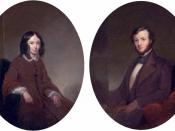Browning's dramatic monologue does effectively capture the essence of a damaged personality through the various techniques that the monologue contains. For instance the personification in the lines "The sullen wind soon awake... And did its worse to vex the lake", reflects the persona's emotions and gives what he is about to do intention which is shown through the example of the wind blowing the tree down with no intention. This also sets an aggressive setting for the responder which links with the intense imagery and descriptive language. Descriptive language such as "dripping" and struggling" creates a visual image and also sets the scene. It shows that the persona is watching Porphyria's every move which emphasises his obsession with her.
Another technique that shows that the persona is not entirely himself is the use of third person. As the rest of the poem is written in first person a line written in third person such as "when no voice replied" shows that the persona is not himself and it hints to the responder that there may be some insanity involved in what he is about to do.
It also shows that he has no control over what he is doing.
"Mine, mine" is an example of repetition. These words emphasise the emotional triumph and the emotional intensity to the responder. It shows that the persona can't believe that Porphyria is finally his. "No pain, No pain" is another example of repetition in this monologue. These words justify his doings and links to the concept of madness. He believes that he just strangled her, but it is okay as she felt no pain. The repetition of and in the lines "And thus we sit together now... And yet God has not said a word!" shows order of actions as well as insanity...



Good Stuff
The essay appears to be a good piece and excellent understanding of the poem.
1 out of 1 people found this comment useful.